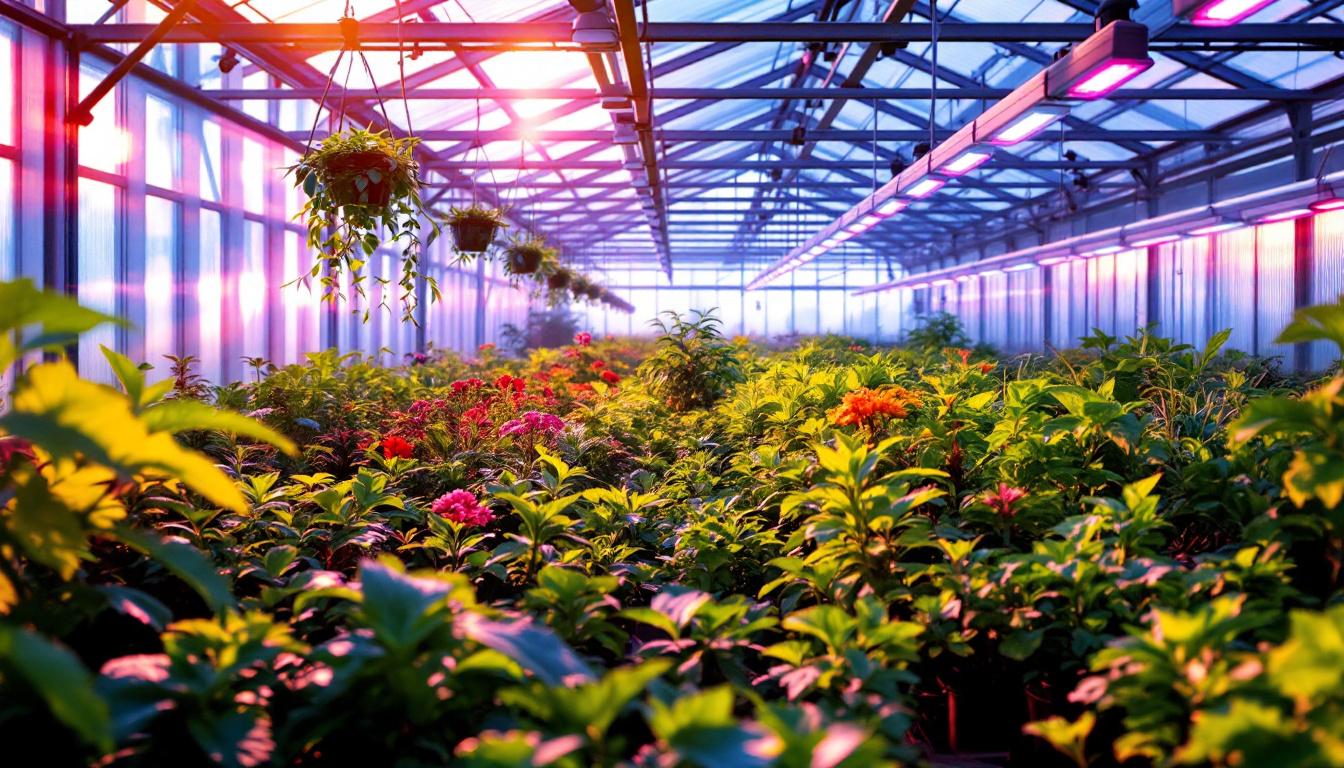
Greenhouses serve as controlled environments for growing plants, allowing for year-round cultivation regardless of external weather conditions. However, one of the most critical factors in maintaining optimal growth is adequate lighting. The right lighting solutions can significantly influence plant health, growth rates, and overall yield, making it essential for lighting contractors to understand the specific needs of greenhouse lighting.
Plants rely on light for photosynthesis, the process by which they convert light energy into chemical energy. In a greenhouse setting, natural sunlight can sometimes be insufficient, especially during shorter days or in regions with less sunlight. This is where artificial lighting comes into play, providing the necessary spectrum and intensity to support plant growth. By integrating artificial lighting systems, growers can effectively extend the growing season and enhance the productivity of their greenhouses, allowing for a diverse array of crops to be cultivated throughout the year.
Different plants have varying light spectrum requirements, which can affect their growth stages. For instance, blue light is crucial for vegetative growth, while red light is essential for flowering and fruiting. Understanding these needs allows lighting contractors to tailor their solutions to specific crops, ensuring that each plant receives the optimal light for its growth phase. Additionally, the incorporation of full-spectrum lighting can simulate natural sunlight, providing a more balanced light source that promotes overall plant health. This is particularly beneficial for seedlings and young plants, which are sensitive to light variations and require consistent conditions for robust development.
Modern lighting technologies, such as LED systems, offer the advantage of customizable light spectrums. This flexibility enables growers to adjust the light output according to the specific requirements of their plants, enhancing growth efficiency and crop quality. Furthermore, advances in smart lighting technology allow for automated adjustments based on real-time data, such as temperature and humidity levels, ensuring that plants receive the ideal lighting conditions throughout their growth cycle.
In addition to the spectrum, the intensity and duration of light exposure are vital components in greenhouse lighting. Different plants require varying light intensities, and insufficient light can lead to poor growth or even plant death. Conversely, excessive light can cause stress and damage. Therefore, it is essential to strike a balance that meets the needs of the plants being cultivated. Lighting contractors must also consider the placement of lighting fixtures, as the distance from the plants can significantly impact light intensity. Properly designed lighting layouts can help ensure uniform light distribution, preventing shaded areas that may hinder growth.
Moreover, the duration of light exposure, often referred to as photoperiod, plays a significant role in plant development. Some plants thrive under long photoperiods, while others require shorter durations. Lighting contractors must consider these factors when designing lighting systems for greenhouses, ensuring that they can provide the appropriate intensity and duration for optimal plant health. Additionally, incorporating timers and programmable lighting schedules can help mimic natural light cycles, further promoting healthy growth patterns. This attention to detail not only enhances plant vitality but also optimizes energy usage, making greenhouse operations more sustainable and cost-effective in the long run.
With advancements in technology, several lighting options are available for greenhouse applications. Each type of lighting solution offers unique benefits and challenges, making it crucial for lighting contractors to evaluate the specific needs of each greenhouse before making recommendations.
LED lighting has emerged as a frontrunner in greenhouse applications due to its energy efficiency and versatility. LEDs consume significantly less energy compared to traditional lighting solutions, such as incandescent and fluorescent lights, resulting in lower operational costs. Additionally, they have a longer lifespan, reducing the frequency of replacements and maintenance.
One of the most significant advantages of LED technology is its ability to produce specific light spectrums tailored to the needs of various plants. This capability allows for targeted growth strategies, enabling growers to maximize their yields while minimizing energy consumption. Furthermore, the low heat output of LEDs reduces the risk of overheating plants, creating a more stable growing environment. Beyond energy savings, LEDs can also be integrated with smart technology, allowing for automated adjustments based on real-time data regarding plant growth and environmental conditions. This level of control not only enhances plant health but also optimizes resource use, making it an attractive option for modern greenhouse operations.
High-Intensity Discharge (HID) lighting, including metal halide and high-pressure sodium lamps, has been a popular choice for greenhouse lighting for many years. These systems provide a high output of light, making them suitable for large-scale operations. HID lights are particularly effective during the flowering and fruiting stages of plant growth, as they emit a broad spectrum of light.
However, HID systems come with some drawbacks. They tend to consume more energy than LEDs and generate significant heat, which can lead to increased cooling costs in the greenhouse. Additionally, the lifespan of HID bulbs is shorter than that of LEDs, requiring more frequent replacements. Lighting contractors must weigh these factors against the benefits when recommending HID solutions. Moreover, the ballast required for HID systems can add to the complexity and cost of installation. Despite these challenges, many growers still prefer HID lighting for its ability to deliver high-intensity light that can penetrate dense foliage, making it a staple in commercial horticulture.
Fluorescent lighting is another option for greenhouse applications, particularly for smaller operations or specific growing tasks, such as starting seedlings. These lights are relatively inexpensive and provide a good spectrum for vegetative growth. They are also energy-efficient compared to traditional incandescent bulbs.
However, fluorescent lights typically have a lower light output than LEDs and HID systems, which may limit their effectiveness in larger greenhouses. Additionally, they have a shorter lifespan and may require more frequent replacements. Lighting contractors should consider the scale of the operation and the specific needs of the plants when recommending fluorescent lighting solutions. Despite their limitations, fluorescent lights can be beneficial for specific applications, such as propagation and cloning, where lower light levels are adequate. Their ability to be easily installed in various configurations, including vertical setups, makes them a flexible choice for growers looking to optimize space. Furthermore, advancements in fluorescent technology, such as T5 and T8 bulbs, have improved their efficiency and light quality, allowing them to remain a viable option for many greenhouse environments.
As the greenhouse industry evolves, the integration of technology into lighting solutions has become increasingly important. Smart lighting systems, automation, and data analytics are transforming how growers manage their lighting needs, leading to improved efficiency and productivity.
Smart lighting systems allow growers to control their greenhouse lighting remotely, adjusting settings based on real-time data and environmental conditions. This capability enables precise control over light intensity, spectrum, and duration, ensuring that plants receive the optimal lighting conditions at all times.
These systems can also be programmed to respond to changes in external light levels, automatically adjusting to maintain consistent lighting conditions. This adaptability not only enhances plant growth but also contributes to energy savings, as lights can be dimmed or turned off when natural sunlight is sufficient.
Automation plays a critical role in modern greenhouse lighting solutions. By incorporating sensors that monitor environmental conditions, such as temperature and humidity, growers can optimize their lighting systems for maximum efficiency. For example, if a sensor detects that the greenhouse is too warm, the lighting system can automatically reduce intensity or switch off entirely to prevent overheating.
Additionally, automation can streamline the management of photoperiods for different plant species, ensuring that each crop receives the appropriate light exposure. This level of control not only improves plant health but also allows for more precise scheduling, reducing labor costs and increasing productivity.
As environmental concerns continue to rise, energy efficiency and sustainability have become paramount in greenhouse operations. Lighting contractors play a crucial role in helping growers adopt solutions that minimize energy consumption while maximizing productivity.
Implementing energy-efficient lighting solutions, such as LED systems, can significantly reduce energy consumption in greenhouses. By consuming less power and producing less heat, these systems lower operational costs and contribute to a more sustainable growing environment. Additionally, energy-efficient lighting can help growers qualify for various incentives and rebates aimed at promoting sustainable practices.
Moreover, integrating smart lighting systems and automation can further enhance energy efficiency. By utilizing data-driven insights to optimize lighting conditions, growers can minimize waste and ensure that energy is used effectively, ultimately leading to a more sustainable operation.
Lighting contractors can also assist growers in implementing sustainable practices beyond energy efficiency. For instance, recommending lighting solutions that utilize renewable energy sources, such as solar power, can further reduce the carbon footprint of greenhouse operations. Additionally, educating growers about the importance of recycling and proper disposal of lighting materials can contribute to a more sustainable industry.
By promoting sustainable practices and energy-efficient solutions, lighting contractors can help shape a greener future for the greenhouse industry, ensuring that it remains viable and environmentally responsible.
In the modern greenhouse industry, lighting plays a pivotal role in ensuring successful plant growth and maximizing yields. As lighting contractors navigate the diverse landscape of lighting solutions, understanding the specific needs of greenhouse operations is essential. From selecting the appropriate type of lighting to integrating technology and promoting sustainability, the role of lighting in greenhouses is multifaceted and ever-evolving.
By embracing innovative lighting solutions and staying informed about advancements in technology, lighting contractors can provide valuable support to growers, helping them achieve their goals while contributing to a more sustainable future. The future of greenhouse lighting is bright, and with the right approach, it can lead to thriving plants and successful operations.
Ready to enhance your greenhouse operations with the best lighting solutions on the market? At LumenWholesale, we provide lighting contractors with the highest quality, spec-grade lighting products at prices that can’t be beaten. Our extensive selection is designed to meet the rigorous demands of modern greenhouse lighting, ensuring reliability and high performance for every project. Say goodbye to inflated markups and enjoy the convenience of bulk buying with free shipping. Elevate your greenhouse with premium lighting that combines quality, affordability, and convenience. Discover wholesale lighting at the best value today and watch your greenhouse thrive.

Discover essential insights into 6 ft LED light strips with our comprehensive guide tailored for lighting contractors.

Discover essential tips and expert advice for lighting contractors on selecting and installing 2X2 flat panel LED lights.

Discover the ultimate guide for lighting contractors on using string LED lights with remote controls.

Discover essential insights for lighting contractors on optimizing classroom environments.